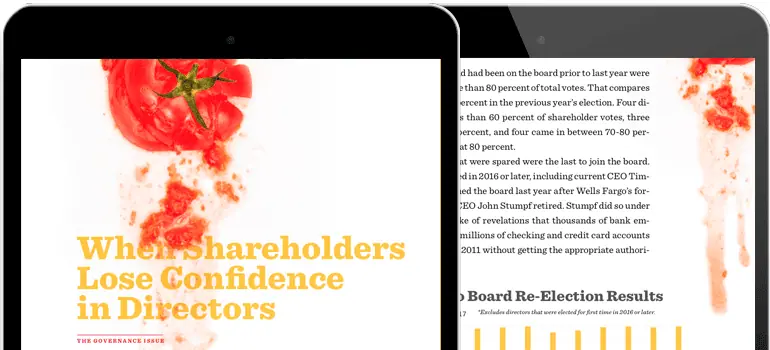
When Shareholders Lose Confidence in Directors

Wells Fargo’s directors have held on tight to their seats in the boardroom for the past year, as the California-based bank with $1.9 trillion in assets struggled through one of the rockiest stretches in its 165-year history. Three directors finally gave way in August, when it was reported that two long-serving board members, as well as the bank’s current chairman, Stephen Sanger, would retire at the end of this year.
The decision came after the directors received what was widely viewed as a vote of no confidence from shareholders at the bank’s annual meeting four months earlier. But while the news seemed inevitable, the reality is that it remains far from settled how directors in a situation like this should respond after receiving tepid support from shareholders in a bid for re-election to the board.
A report issued prior to the vote by Institutional Shareholder Services (ISS), a proxy advisory firm that advises institutional investors on how to vote in elections of public companies, urged clients to vote against all but three members of the bank’s board. The board committees “tasked with risk oversight failed over a number of years to provide a timely and sufficient risk oversight process that should have mitigated the harmful impact of the unsound retail banking sales practices that occurred from 2011-2016,” states the report.
Sen. Elizabeth Warren echoed this recommendation in a letter sent a few months later to the Federal Reserve. “The Federal Reserve must hold the Wells Fargo board members accountable for their risk-management failures,” wrote the Massachusetts senator. Warren then called on the central bank to remove 12 of the bank’s 15 directors.
Shareholders of Wells Fargo largely agreed with this sentiment. At its annual meeting in April, none of the 12 directors that were up for re-election and had been on the board prior to last year were re-elected with more than 80 percent of total votes. That compares to an average of 98 percent in the previous year’s election. Four directors received less than 60 percent of shareholder votes, three got between 60-70 percent, and four came in between 70-80 percent, with one right at 80 percent.
The directors that were spared were the last to join the board. All three were elected in 2016 or later, including current CEO Timothy Sloan, who joined the board last year after Wells Fargo’s former chairman and CEO John Stumpf retired. Stumpf did so under pressure, in the wake of revelations that thousands of bank employees had opened millions of checking and credit card accounts for customers since 2011 without getting the appropriate authorization to do so.
Shareholder votes like these are rare, given that directors tend in most cases to be reelected with near-unanimous support. The most prominent time it happened previously in the banking industry was in 2013, after JPMorgan Chase & Co.’s London Whale scandal, when a pair of directors stepped down after receiving less than 60 percent of shareholder votes in favor of re-election to the board earlier in the year.
Yet, despite their infrequence, underwhelming majority votes for director re-elections like this are growing more common. So far this year, 113 board members of S&P 500 companies received less than 80 percent of shareholder votes in favor of re-election. That’s up from an average of 72 directors over the four previous years. This evolution has led to a split in opinion about what exactly constitutes a vote of no confidence for the purpose of director elections.
“I think that if you don’t receive a significant shareholder vote, you need to make room for new blood. That means anything that’s below 80 percent, 70 percent and certainly anything below 60 percent,” says Charles Elson, a professor of finance at the University of Delaware and the director of the John L. Weinberg Center for Corporate Governance. “In a company with as diversified a shareholder base as Wells Fargo, numbers that low are significant. It takes quite a bit to get that many shareholders together.”
A similar threshold is cited by Alexandra Higgins, associate vice president of ISS Corporate Solutions. “When a director receives less than 80 percent support, they are effectively in the bottom 5 percent of director election outcomes,” says Higgins. She went on to note, however, that each situation is unique. “If a director receives less than majority support for failing to attend 75 percent or more of board meetings, the situation is less material than a director on an audit committee who failed to identify ongoing and long-term accounting irregularities,” says Higgins.
Other corporate governance experts are less inclined to support a bright-line rule on top of an existing majority voting standard. “I don’t think there is as much a bright line as a rule of reason,” says James McAlpin, a partner at Bryan Cave and head of the firm’s Financial Services Client Service Group. “In my opinion, if a director up for re-election receives less than 70 percent of the shareholder vote, a strong message is being sent.”
This opinion is echoed by Lawrence Cunningham, professor of business law at George Washington University, and editor and publisher of “The Essays of Warren Buffett: Lessons for Corporate America.” “I don’t think there should be a blanket rule that says if a director receives less than 65 percent or whatever of the vote, that they should automatically resign,” says Cunningham. “I don’t think there should be any rule like that. But if I were a director and received a vote like the one at Wells Fargo, I’d step down.”
The evolution of corporate governance has meant that more companies are making it tougher to get re-elected than it was in the past. “This is a big debate in corporate governance right now,” says Cunningham. Until 20 years ago, almost every company rule on voting meant that directors won re-election if they won a plurality of votes, not a majority, he says. In that case, if elections weren’t contested, a director could win with as little as one vote. To this end, over the past five years, the percentage of companies on the S&P 500 that require a majority vote for director elections has increased from 75 percent in 2013 up to 84 percent this year, according to data from ISS Corporate Solutions.
This is an area of law and corporate governance that’s in flux, in other words. That aside, whether the threshold for a no-confidence vote is 50 percent or 80 percent, many believe that, at least in the case of Wells Fargo, it took too long for directors to resign. “The right thing to do in this situation is to immediately resign,” says Cunningham. “It is appalling when companies rationalize letting directors who get low votes to remain in office when the vote signals lack of trust or confidence.”

Join OUr Community
Bank Director’s annual Bank Services Membership Program combines Bank Director’s extensive online library of director training materials, conferences, our quarterly publication, and access to FinXTech Connect.
Become a Member
Our commitment to those leaders who believe a strong board makes a strong bank never wavers.



